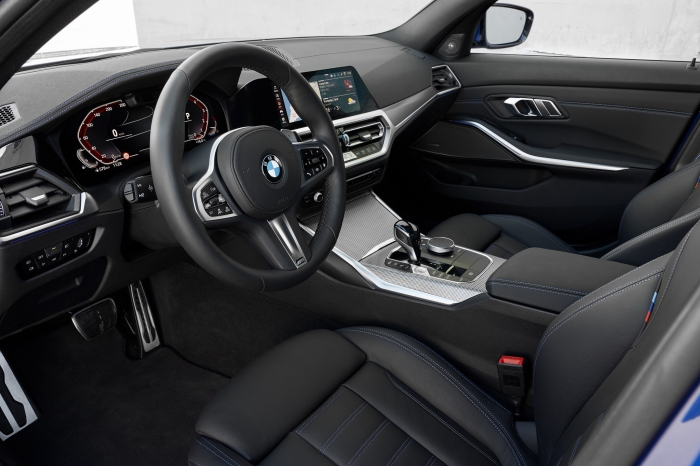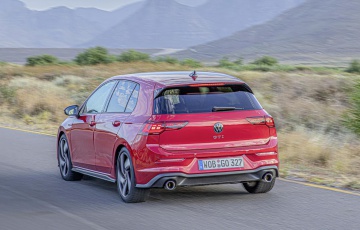.357 Punch : BMW G20 330i M Sport Driven [review]

BMW’s new seventh-gen G20 3 Series takes the sport sedan into the 21st century

Faro, Portugal – The BMW 3 Series is the most BMW-BMW of them all. It’s the car that delivered the Bavarian company the sales boost it needed to go big, and redefined the idea of what a sedan can do by being the best, most popular form of the sport sedan was we now know it.
BMW likes to say it invented the sport sedan category with the 3er, and it’s not wrong, either, more than four decades and 15-million units later.

To normal people, it’s the default BMW just because. But to enthusiast drivers, it’s the one to buy because it’s the best to drive. But six generations on, is that still true of the new seventh-gen ‘G20’ 3 Series?
Before we start there’s some all-important details to lay bare: Our test car shown here in Portimao Blue Metallic in M Sport trim came with all the extras. M Sport gives you the usual body kit, M-themed parts (steering wheel, seatbelts, door sills, etc) but the notable options are M Sport Suspension, M Variable Sport Steering, bigger M Sport Brakes, and the new M Active Differential. As usual, international spec and Singapore spec will differ at the expected local debut of Q2 2019.

The car will be offered at launch in two variants, 320i and 330i, with the 330e plug-in hybrid and M340i performance model to follow in July 2019 – for Singapore that means late 2019, or even early 2020. There’s no official word of an entry-level 318i yet, but we can surely expect one to appear eventually with the same 1.5-litre three-cylinder engine the current model has.

The fat-M steering wheel seems to have become, quite ridiculous-y, even fatter than before. It’s like holding a jumbo Bockwurst in your hands and feels silly. BMW says that globally, customers like it, but we don’t and is one thing we consistently disagree with.
The good thing? This is the only undisputed, major peeve we can muster of the G20.

Speaking of major, the car’s size increase is prodigious, 76mm increase in length, 41mm in wheelbase, 43mm to front track and 21mm to rear track. From the outside, the dimensions might not strike you as belonging to a 3er at all – it’s really more of a baby 5er, in appearance and demeanour, and a baby 7er in technological spirit.
From behind the wheel, the 3 feels like the figures suggest, obviously wider, and more sizeable. The M Sport Suspension setup is by default, quite stiff, and driving around small towns near Portimao isn’t an enjoyable experience in the long haul.

But isn’t one-dimensionally stiff, like a crossover, where the setup is a dam holding back top-heavy drawbacks and the stiffness doesn’t translate into any dynamic benefits. It’s the opposite, with a base setup that can tackle almost anything.
BMW’s innovation here is ‘lift-related dampers’. The 3 Series’ dynamics engineer, Albert Maier, explains that it’s a fully hydraulic system, with an additional internal piston collar in the middle of the travel, which makes the damper force increase the more it the pistol travels.
In other words, a conventional damper with adaptive capabilities. It works on the front only in rebound, to counter front end ‘float’ and lack of feel after bumps, and on the rear axle in compression, to reduce squat. It works a charm to make the 3er even better, and easier, to drive fast. At the very first real corner taken at speed – a highway on-ramp – the 330i dives in like it’s born for bends.

For a moment we wonder what just happened, there wasn’t much drama. No diving under braking, a hint of roll on the turn-in, and no squat when blasting out of the turn, the slightly updated 2.0-litre engine pumping out a useful six horsepower and 50Nm more than previous. Having a rorty engine note that sounds better than the lifeless drone of Mercedes and Audi units helps too.

On the highway, the 3 Series seems to have gained a limitless appetite for speed. Adding velocity doesn’t faze it at all, and soon we arrive at unprintable speeds, but the passengers are calm and not doing the usual cat-at-a-vet impressions in the cabin.
New acoustic glass (dual-layer front windows are optional) and a slippery Cd figure really help, the 3er just gliding along serenely, with the positive front end egging the driver to add even more velocity. Seriously, it’s easier to drive at autobahn speed than the current 5 Series is.

Once we’re in the squiggly tarmac of the hills, there’s just as little drama as the highway. Like its ancestors, the 330i is born for A- and B-roads. Other drivers will surely label you a ‘BMW A-word’ but one really can’t help it since it’s so easy – and enjoyable – to hustle the car along on roads that would give the majority of normal cars pause.
There’s so much traction is doesn’t even give its tyres an expected squeal when you do load it heavy in the corner, the engine always ready to serve up the torque you need, and if not for the lovely handling, you’d think this was an all-wheel drive car. The M Differential, an electro-mechanical clutch pack able to shift torque super-quick, is no doubt of great benefit in these conditions. It’s a hugely flexible car, and at times we had to remind ourselves this is still a ‘compact executive sedan’.

Flexibility also covers your driving style. The 3er is meant for proper drivers, and the G20 can accommodate both a ragged, white-knuckle, big-input method, or a smooth, economy-fast one with equally rewarding results.
If there’s anything to lament, it’s the baked-in remnant of rawness the previous 3 Series retained has now been firmly eradicated, replaced by refinement, huge pace, and ruthless capability. The steering feel also seems less than before, though the steering’s precision is very high.

The classic 3er sense of driver intimacy is also lessened, simply because the cabin is so much larger and feels airier, and, quite ironically, because there are so many ways to interact with the car now.
The design approach brings the 3er into the latest BMW mark in terms of quality, with stronger lines, lots of satin metal surfaces, no cheap plastic in sight. Enter sight unseen and one could easily be convinced it’s the cabin of a theoretical next-gen 5 Series.

BMW calls the new cockpit concept BMW OS 7.0, which serves up digitised instruments, huge infotainment touchscreen, and centralised control section (gearshifter, ‘iDrive’ rotary controller, buttons, drive modes).
A significant new feature is BMW’s Intelligent Personal Assistant (IPA). It’s like Mercedes’ MBUX with voice control, but a little more adroit, and can truly be termed BMW’s own version of Siri, in-car. Voice control has come a long, long way, it’s totally unlike old systems that could never seem to grasp what you were saying no matter how long or clearly you enunciated the words.
IPA can understand different voices and tones (we tried Yoda and Batman impressions to attempt to bamboozle it), and you can also use it to do anything from navigate (‘Find me a Starbucks’) to find out about the car (‘When is my next service?’). As far as talking to a car goes, the 3 Series marks the nearest realisation to KITT we’ve ever experienced.

Lastly, the 3er is also capable of Level 3 Autonomy – like Audi’s A8 – it allows the driver to go fully hands-free at speeds below 60km/h in traffic jam situations. The caveat is that it’s only legal in the USA and China, and since Audi hasn’t gotten approval for Level 3 in Singapore yet, and legislation-wise the laws to support it simply don’t exist, so it doesn’t look like it’ll happen anytime soon for the 3er either.
To involved drivers that’s just window dressing really, but it’s good to know the 3er is future proof nonetheless.

Like all new-gen, old-icons of motoring, the new 3 Series has abilities its predecessors couldn’t dream of, even if some of that old-school, plugged-in feel is lost in the process. The latter is pretty much unavoidable – see VW Golf GTI and Porsche 911 for good examples of the relentless crush of technology. In the process the 3 Series has become faster, and possibly even more refined than a 5 Series, while packing more technology than a 7, while still keeping its keen driving edge.
That can’t be anything but a win for it, no matter who the audience is.
PHOTOS BMW

BMW 330i M Sport
Engine 1998cc, inline4, turbocharged
Power/rpm 255bhp/5000-6500rpm
Torque/rpm 400Nm/1550-4400rpm
Transmission 8spd auto
0-100km/h 5.8secs
Top Speed 250km/h
Fuel Consumption 6l/100km
CO2 136g/km









